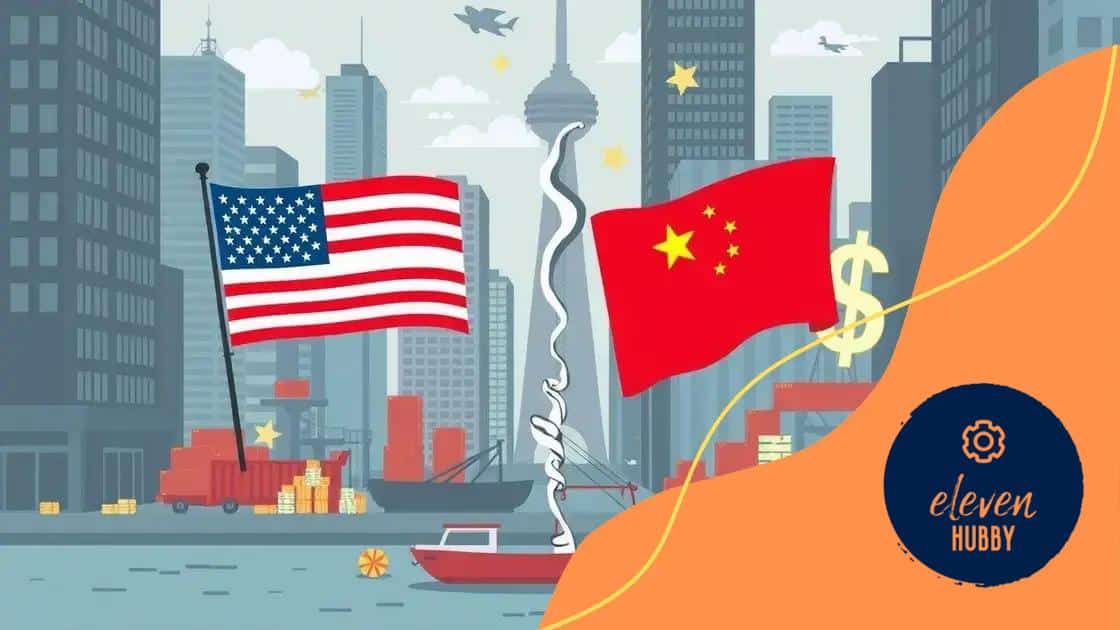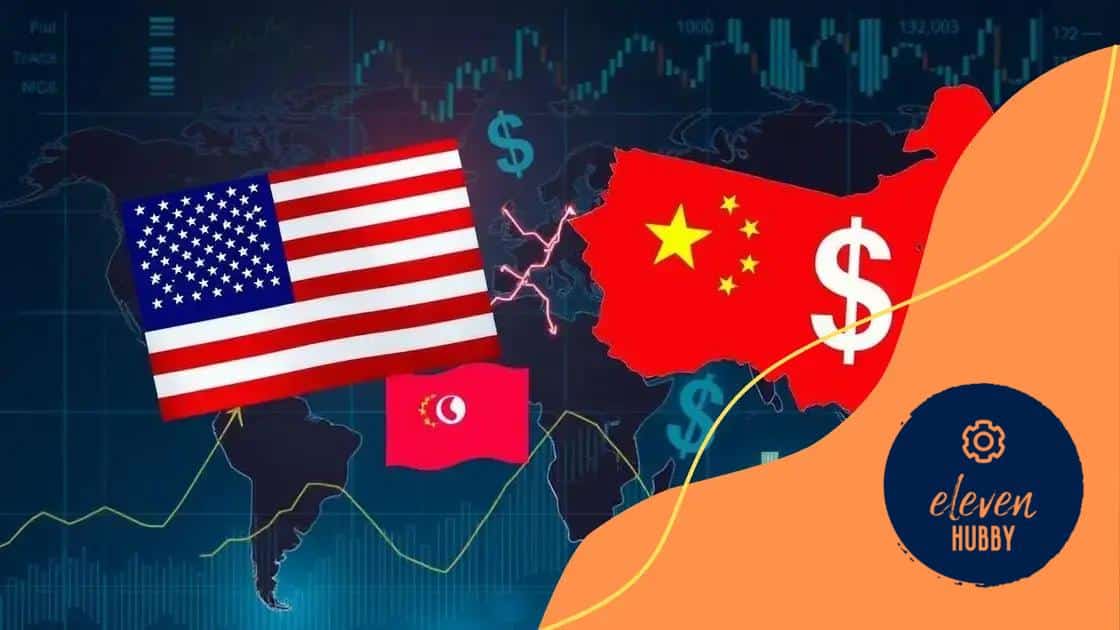US-China trade tensions grow: what you need to know

US-China trade tensions are driven by tariffs, intellectual property disputes, and geopolitical competition, significantly impacting consumer prices, global markets, and international relations.
US-China trade tensions grow and continue to influence global trade dynamics. But what exactly does this mean for everyday consumers and businesses? Let’s dive into the factors at play and their implications.
Historical context of US-China trade relations
The historical context of US-China trade relations has evolved significantly over the years. Understanding this background is essential as it shapes the current trade dynamics between these two economic giants.
Since the late 20th century, trade between the United States and China has witnessed dramatic changes. The relationship opened up significantly after China joined the World Trade Organization (WTO) in 2001, enabling broader trade opportunities. This move was celebrated by many, as it aimed to integrate China more deeply into the global market.
Key milestones in US-China trade history
Several crucial events helped shape the ongoing trade relationship:
- The establishment of diplomatic relations in 1979 marked the beginning of formal trade discussions.
- China’s accession to the WTO in 2001 facilitated a surge in exports.
- Trade imbalances grew over the years, with a notable deficit on the US side.
This historical backdrop set the stage for modern-day tensions. As both nations continued to grow economically, the trade policies and practices began to draw scrutiny. The US has raised concerns over issues like intellectual property theft and market access.
The changing landscape of trade
As trade relations progressed, shifts in policies emerged. Tariffs were introduced, aiming to protect domestic industries. The implications of these tariffs contributed to job losses and price increases for consumers.
The impact of such policies extends beyond economics; they also influence diplomacy. Trade relations have often fallen prey to broader geopolitical concerns, affecting military and political alliances.
Furthermore, discussions around sustainability and ethical sourcing have begun to play a role in shaping trade agreements. As markets evolve, so do the expectations from consumers and governments.
Thus, understanding the historical context of US-China trade relations is vital for grasping the complexities of current tensions. The interplay between economics, politics, and social factors continues to drive the narrative forward.
Overall, the trajectory of US-China trade highlights the significance of history in shaping the future of globalization. With ongoing negotiations, it remains essential to watch how these two countries address their differences.
Key events leading to rising tensions
Several key events leading to rising tensions in US-China trade relations have shaped the current landscape. Understanding these milestones is essential for grasping the complexities of the ongoing trade conflict.
One significant event occurred in 2018 when the United States imposed tariffs on a wide range of Chinese goods. This move was aimed at reducing the trade deficit and addressing issues like intellectual property theft. The tariffs triggered retaliatory actions from China, escalating the trade dispute further.
Major Turning Points in the Trade Dispute
Other notable events have also contributed to growing unrest:
- The 2020 trade agreement, which aimed to ease tensions, faced challenges as both countries struggled to meet their commitments.
- Heightened scrutiny on Chinese technology firms, including Huawei, marked a shift towards more aggressive measures from the US government.
- COVID-19 intensified accusations, with the US blaming China for not being transparent about the virus’s origins.
The impact of these events has been felt on both sides. As tariffs rose, U.S. companies faced higher production costs, leading to price increases for consumers. This shift in trade policies has forced many companies to reconsider their sourcing strategies, seeking alternatives outside of China.
The Role of Geopolitical Factors
Beyond just economics, rising tensions have roots in geopolitical factors. The competition for global influence between the two nations plays a crucial role. The US has been increasingly cautious about China’s expanding reach in areas like technology and military strength.
As both countries navigate these complex relationships, the interplay between trade, politics, and national security continues to evolve. The future of US-China trade relations remains uncertain, raising questions about how these key events will influence negotiations moving forward.
Economic impact on global markets

The economic impact on global markets from US-China trade tensions is significant and far-reaching. As trade disputes escalate, they create ripples that affect economies around the world.
One of the primary effects is the disruption of supply chains. Many businesses rely on imported goods and raw materials from China. When tariffs are imposed, costs increase. This leads to higher prices for consumers, affecting purchasing power.
Effects on Global Trade
Countries around the globe feel the consequences of these tensions:
- Emerging markets become vulnerable to shifts in demand as US and China adjust their trade policies.
- Investment flows are affected as companies seek to avoid markets susceptible to instability.
- Commodity prices fluctuate based on supply and demand dynamics, impacting economies reliant on exports.
Additionally, major stock markets react to news from trade negotiations. Investors often respond to uncertainty with caution, causing a decline in stock prices. This volatility creates an environment where companies may delay investments or hiring.
Long-term Implications for Global Economy
In the long run, these trade tensions can reshape economic policies. Countries may focus on developing partnerships that bypass reliance on US or Chinese markets. This shift could lead to a more multipolar world, where trade is diversified.
Furthermore, businesses may begin to localize production to mitigate risks associated with tariffs. This change can lead to job growth in some regions while causing hardship in others, as industries transition.
The global economy is intricately linked, and the impact of US-China relations will continue to evolve. Observers must keep an eye on these developments to understand future trends better.
Political ramifications of the trade war
The political ramifications of the trade war between the US and China are profound and far-reaching. These tensions do not just affect trade; they influence diplomatic relations and global policies.
One key aspect is how trade disputes reshape alliances. For example, countries that previously relied on China for trade may reassess their positions. This could lead to new partnerships that are more favorable to US interests, altering power dynamics in various regions.
Impact on Domestic Politics
Domestically, these tensions are also seen in political discourse. Politicians leverage the trade war to rally support by emphasizing national security concerns. Such rhetoric can create a more nationalistic environment, where economic policies are driven by the desire to protect domestic industries.
- The trade war influences elections, as candidates address voter concerns about job losses and rising prices.
- There is pressure on policymakers to support struggling sectors, which can lead to government subsidies and tariff adjustments.
- Media coverage often highlights these issues, shaping public perception and reaction.
Additionally, trade policies can impact legislation on technology and security. With heightened scrutiny on foreign investments—especially from China—new laws may emerge to protect sensitive industries. This may affect sectors like telecommunications and pharmaceuticals, which are vital for national interests.
Global Diplomatic Relations
On a global scale, the trade war has led to changes in diplomatic relations. Countries must navigate their own interests while balancing pressure from both the US and China. Some nations may feel compelled to take sides or mediate between the two powers.
International organizations, such as the World Trade Organization (WTO), may face challenges in addressing disputes. As tensions rise, finding common ground becomes increasingly difficult, complicating long-term resolutions.
The ongoing trade war sends a message that economic competition can overlap with geopolitical strategy. Understanding these political ramifications is essential for predicting how future relations will evolve.
Future outlook and potential resolutions
The future outlook and potential resolutions of US-China trade tensions are uncertain but critical for both nations and the global economy. As both countries navigate their differences, the potential for resolution remains a topic of great interest.
One possible outcome is further negotiations. Both the US and China may find it beneficial to return to the negotiating table to reach a comprehensive agreement that addresses key issues. This could include topics like intellectual property rights, tariffs, and trade imbalances. Cooperation in these areas might ease tensions and foster a more stable relationship.
International Mediation
Another avenue for resolution could involve third-party mediation. Organizations such as the World Trade Organization (WTO) can play a role in facilitating discussions and providing a neutral ground for both parties. Mediation can help de-escalate conflicts and promote fair trade practices, ensuring both nations adhere to international rules.
- Increased dialogue may lead to trust-building measures.
- International cooperation could set the stage for long-term agreements.
- Addressing global trade issues jointly may benefit other nations impacted by tensions.
Additionally, shifts in global economic dynamics may influence the future of US-China trade. As emerging markets gain prominence, both nations might need to adapt their strategies. This change could encourage collaboration over competition in certain sectors.
Adaptation of Trade Policies
Adapting trade policies will also be crucial for both the US and China. Emphasizing sustainable trade practices and responding to consumer preferences might lead to enhanced trade relations. Businesses on both sides may begin to prioritize sustainability and ethical sourcing as markets evolve.
In summary, the future of US-China relations depends heavily on diplomatic efforts, trade policy adaptations, and global economic shifts. While challenges remain, possibilities for cooperation and resolution exist, suggesting a complex yet hopeful landscape ahead.
FAQ – Frequently Asked Questions about US-China Trade Tensions
What are the main causes of US-China trade tensions?
The main causes include tariffs, intellectual property concerns, trade imbalances, and geopolitical competition.
How do trade tensions affect consumers?
Trade tensions can lead to higher prices on goods, as tariffs increase production costs, affecting consumer purchasing power.
What are possible solutions to the trade conflict?
Possible solutions may involve negotiations, international mediation, and adapting trade policies for better cooperation.
How do trade tensions impact global markets?
Trade tensions create volatility in global markets, affecting investments, stock prices, and international trade dynamics.






